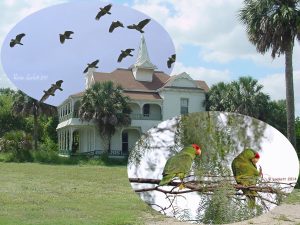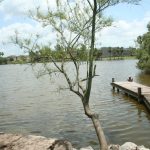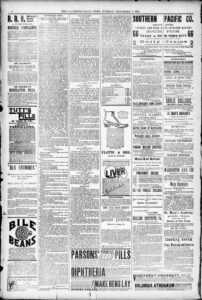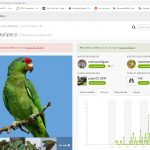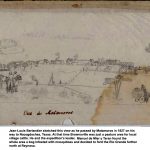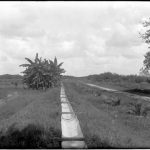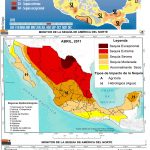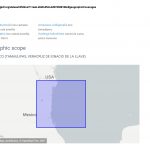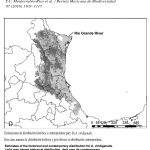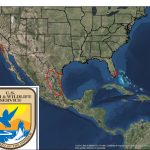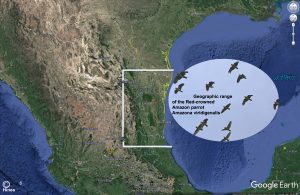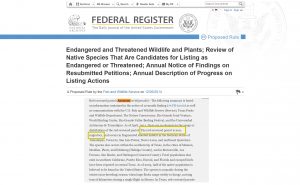The Red-Crowned Parrots Of Brownsville Texas Fight For Their Citizenship
Ron Hines DVM PhD
My house sits on an old bend of the Rio Grande River – one the River abandoned years ago, having found a more direct path to the sea. We call these river bend remnants resacas.
I bought the property from the Nature Conservancy. The Conservancy had judged this parcel too small for their broader mission. Every morning, the red-crowned parrots nesting in a palm tree across the resaca cheer me with their calls, their comings and their goings. They have done so since I was a boy. I spend my days now caring for the injured wildlife that Texas Parks & Wildlife and the US Fish & Wildlife Service send me. I am the only veterinarian licensed by the USFWS & TPW to do so in my six county area.
Occasionally, local wild red-crowned parrots and green conures are brought to me by the game wardens. 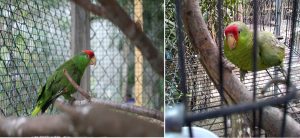
However, the game wardens, the US Fish & Wildlife Service and I are at a disadvantage because our local parrots are officially considered feral, that is, escaped pets – not native wildlife. That is a fallacy, convenient to some, a burden to others. I wrote this article to give the red-crowned parrots of the Texas Rio Grande Valley a chance to tell their side of the story. And while I am at it, I am going to tell you a bit about the trafficking that has driven many wild parrots close to extinction and about politics and special interests with their thumbs on the scale when decisions to protect them need to be made. It’s a story that will affect the lives of the parrots nesting in the palm tree across my resaca.
Rio Grande Valley park rangers estimate that there are 700-750 red-crowned parrots living between Brownsville and McAllen Texas in 2019. That could be an underestimate. Red-crowned parrots can only be counted accurately in the fall and winter months when they form large flocks. The tendency of most observers is to underestimate the number of parrots in a large flocks and, due to the nomadic tendency of red-crowned amazon parrots, whole flocks can be missed.
The Long History Of Red-crowned Parrots In The Rio Grande Valley Of Texas:
When I was a boy in the 1950s, red-crowned parrots were common in Brownsville, Texas (my observations and those of my boyhood friends, Don Eddie Moore and Clark Owen). The grandmother of a close friend of mine, “Miss Bliss”, also told me in the 1950s that the same kind of parrots where wild here when she was a small child. Mrs. Bertha Lieck/Bliss was born in 1901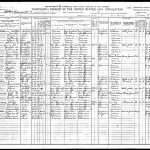
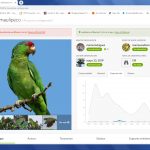
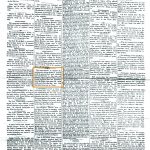
There is good reason why observations of these parrots in the RGV have been sporadic. Unlike most parrots, red-crowned parrots are highly nomadic. It is a necessary genetic trait they developed to prosper in a region where rains are unreliable and where occasional hard winter freezes occur. Both make food sources periodically scarce. Red-crowned parrots are capable of exceedingly long flights and migrations to find sufficient food. When they do, they have never shown respect for national boundaries. Since the 1960s, food sources and safety have been greater in the United States portion of their range. A professor at the University of Arkansas’s tree ring laboratory, Dr. David Stahle, was kind enough to prepared a drought index for me for the years 1751 to 2012 centered on the Mexican portion of the range of the red-crowned parrot . You can view it here:
In 2008 the Environmental Law Clinic of the University of Denver, representing Friends of Animals, sued the USFWS seeking to protect a number of endangered parrots. Among them were the red-crowned parrot of the Rio Grande Valley and Mexico. As a result of that lawsuit, the USFWS undertook a detailed study of the red-crowned parrots and determined that the species was indeed threatened with extinction. At the same time the USFWS made the determination that the Rio Grande Valley is the northernmost part of the parrot’s natural range and that they would be protected here as well under the Endangered Species Act.
However, in 2019 the USFWS reneged on that promise and produced a new map that arbitrarily carves out the tiny portion of the parrot’s United States range in the Rio Grande Valley. Here they label all parrots as escaped pets (“feral”). There is no evidence to support that decision and the theory does not hold water. In the 1950s and 1960s, the time RGV red-crowned parrot numbers began rising, parrots smuggled into South Texas were almost exclusively double yellow-head parrots (DYH). DYH parrots were more desirable pets than red-crowned parrots because of their superior talking ability. Throughout the 1960s, DYH parrots were still relatively common and easy to trap in Mexico. There was no market in Brownsville or across the river in Matamoros for red-crowned parrots. Everyone here knew that the red-crowns’ talking abilities was inferior to that of the double yellow head parrots and that red-crowned parrots had a tendency to scream. I spent much of my time in Matamoros, Mexico and Ciudad Victoria in those days. In the bird shops of Mercado Juarez, and elsewhere, I never saw red-crowned parrots offered.
Why Did The USFWS Arbitrarily Change Their Position?
The reason the USFWS now refuses to admit that red-crowned parrots are native to Texas has nothing to do with scientific research, the welfare of the species, history or common sense. What it has a lot to do with is funding priorities, sweetheart deals with research scientists, and advancement of careers. There is also an element of Mexican nationalism and bowing to the desires of pet parrot breeders – a consortium which fears that recognition of the red-crowned parrots as bona fide US residents will lead to restrictions on their ownership and monetarisation.
If you read the Endangered Species Act, you will find that it is prohibited to “take” (defined by the ESA as harm, harass, kill, injure, etc.) any listed bird within the United States. Experiments, such of those of the Schubot Center at Texas A&M University on our red-crowned parrots would be subject to heightened scrutiny if the birds had legal status in the United States. They actively lobby to prevent the USFWS from extending protection to parrots in the United States because it restricts commerce in these birds. As I write, the Schubot group has personnel in the Rio Grande Valley trapping and placing radio collars on these parrots. They trap the parrots as they return to their nest cavities to feed their young and trap them at feeding stations. All that might have to halt if the parrots gained protective status under the Endangered Species Act. That upsets me greatly. I abhore this sort of cruelty to animals.
Trapping is very traumatic to these intelligent birds. Parrots do not return to feed where their kin have been trapped. Parents abandon nests where they were traumatized. The Schubot Center also has designs on the Rio Grande Valley’s parrots for restocking attempts in Mexico. Experts in bird flight know that if the parrots of the RGV wanted to fly back to Mexico they could do so at any time. We don’t need traumatic studies to track their movements. Many believe that all races of parrots in the Caribbean islands are descended from the white-fronted parrots of Yucatan which also nest in Tamaulipas in the same trees used by red-crowned parrots. They had no problem flying across the 135 miles that separate the Yucatan from Cuba.
Using the RGV parrots in poorly thought out attempts to reestablish them in Mexico are unlikely to be any more successful that a similar 2012 attempt with thick-billed parrots in Arizona.
and for the same reasons. The reason there are fewer red-crowned parrots remaining in Mexico today is habitat loss, poaching and drought. It will be an enjoyable diversion for the A&M folks involved in such a project; but no number of the Valley’s parrots released into a decimated Mexican environment are going to bring them back. Incidentally, thick-billed parrots were deemed native to Arizona by the USFWS based on evidence considerably more flimsy than the evidence USFWS is using today to deny the red-crowned parrots of the RGV native status.
The FWS/TPW most recent study was done hush hush. They were secretive because they knew that the “conclusions” they planned to reach before the “study” was even begun would not sit well with most residents of the RGV. Therefore, experts, such as Dr. Stan Casto and the Audubon Society were not consulted or tipped off that they intended to downgrade these parrot’s legitimacy in the RGV. They did not tip off or ask for input from the members of the GBIF or the IUCN
who had developed rage maps for the birds themselves. Dr. Casto and emeinent Texas ornithologis whose research the entire USFWS and TPW group were or should have been aware of was left unmentioned in their study declaring the red crowned amazon parrot an exotic pest. I am the only USFWS-licensed wild bird rehabilitator in the Rio Grande Valley. Neither myself nor my handlers, Katie Wade-Mathews and Eldon Brown in the USFWS Albuquerque office were tipped off either. The 2016 historic Mexican range maps of Dr. Monterrubio-Rico that shows the birds historic range reaching Matamoros on the US border was never mentioned. I find this quite bizarre in what purports to be an open-minded scientific review. The actual reason was that the USFWS at that time was under heavy political, farm and ranch and commercial pressure not to declare any more species of wildlife to be indigenous to the United States. (
There is another very important reason. The current Administration in Washington is systematically weakening USFWS protection of wild birds throughout America, not just here in the RGV. The Audubon Society is of the opinion that longstanding USFWS policies that protect vulnerable birds are currently being “gutted”. 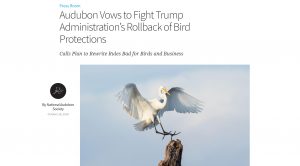
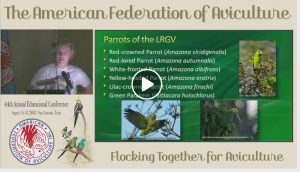
The USFWS’ Failure To Recognize The Effects Of Climate Change On Range And Species Survival
Using the RGV parrot population in an attempt to restock the bird’s more southern range with Texas-born red-crown parrots, as a storehouse and “future insurance policy” for Mexico as some of these people propose relies on a steady climate that emulated the climate of northeastern Mexico over the last 150 years. The USFWS and the Schubot Center seems unaware that the climate of Northern Mexico is changing and will continue to change. They fail to understand that the species hope for survival depends more on the protection of the Rio Grande Valley flocks than it does on the birds remaining in Mexico. The state of Tamaulipas is becoming dryer and hotter – both of which decrease soil moisture and wild sources of food for the parrots. At best, these birds will be forced to feed on agricultural grains and fruits putting them in conflict with the human inhabitants of the region. What is currently occurring in Bolivia could well be a prelude to what would occur in Mexico if such a poorly thought out transfer was attempted. No climatologists are listed as having been consulted when preparing the 2019 USFWS study. These parrots evolved over millennia to adapt their range to the severe droughts that have always plagued northeastern Mexico. That appears to have never been considered by the USFWS. (ask me for redhead-Stahle2016 & redhead-Marvel2019)
Reduced Room In The Mexican Portion Of These Parrot’s Range Remains Unappreciated By The USFWS
In making their decisions, the USFWS failed to appreciate that the sustainability of red-crowned amazon parrot populations in the Mexican portion of their range has been greatly reduced by human population growth, deforestation, modern agricultural practices and nest robbing. There is no room for sizable numbers of these parrots in the majority of their Mexican range any more. In the late 1960s, an acquaintance of mine, Pete M., built a pole hut near the mountains along the banks of the Sabinas River 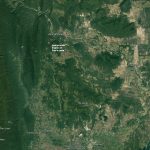
Organized crime in Mexico has also found the parrot trade lucrative. Not only does Mexico City serve as a hub for its illegally captured Mexican parrots, it serves as hub for parrots illegally captured throughout the world.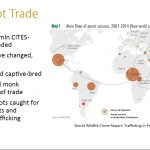

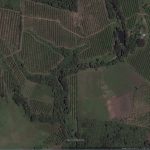
It is not only habitat destruction in Mexico that accounts for the decision of these parrots to move to the northern extremity of their range in the Rio Grande Valley of Texas. Cultural and political issues farther south account for that too. Capturing parrots is deeply rooted in the Hispanoamérican culture of Mexico – going back at least to the time of the Aztec empire. The same issues face the parrots that dwell farther south in Central and South America. I have been immersed in Mexican culture most of my life. Two of my children were born in Matamoros. There is nothing that represents a blessed small town Mexican home more than a small statue of the Virgin of Guadalupe and a parrot in a small cage hanging from a beam on the front porch. My wife fondly recalls the cotorro whose cage hung from her grandma’s porch on Jackson St. in central Brownsville. That is unlikely to change because some “bolillo” from Monterrey, representative from Texas A&M’s Schubot Lab or UTRGV ornithological professor tells them that doing so threatens the survival of these parrots. Many people in the USA are not aware that only 4 – 14% of the parrots captured in Mexico end up smuggled into the United States; the rest feed this Mexican desire for pet parrots. To be fair, there are groups in Mexico, teamed with Defenders Of Wildlife, who are attempting to change those attitudes in future generations.
There is also the factor of nationalism. Why should Mexico share with the United States a species so long associated only with Mexico? 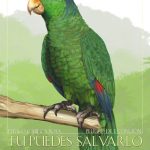
So these parrots are entangled in a deep bureaucratic morass. 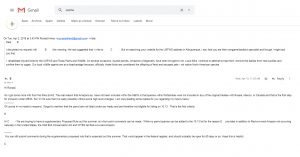
There was a time in the late 1970s when the US Department of Agriculture was seriously considering exterminating the red-crowned parrots of the Rio Grande Valley as foreign invasive pests – a threat to agriculture. That mindset among bureaucrats persists. Only official acknowledgment by the USFWS that the red-crowned parrots are a native species of the RGV would protect them from various government entities.
No Validity To The USFWS’ Escaped Pet/Feral Birds Theory
That theory does not hold water. At the same time that red-crowned parrot numbers began to increase in the RGV, green conure numbers began to increase too. Conures were never a high volume smuggled bird. The heads of a few were dyed yellow and sold to unsuspecting tourists; but the fact that their numbers increased at the same time as red-crowned parrots increased is evidence that it was habitat destruction and climatic changes in Mexico that encouraged the parrots to move to the far northern portions of their range in the US. Many more of the red-crowned parrots and green conures ended up in San Antonio. Undoubtedly, many more escaped there than in the RGV. Yet wild flocks of red-crowned parrots and green parakeets never established flocks north of the RGV. What did establish flocks in San Antonio were monk parakeets and nanday conures originating in Argentina and Bolivia. So it was not cold weather that prevented escaped red-crowned parrots and green parakeets from establishing flocks farther north.
The USFWS’ unwillingness to accept red-crowned parrots as native residents, rests entirely on urban legends propagated by the AFA, about large numbers of red-crowned parrots escaping from boxes being ferried across the Rio Grande River. Red-crowned amazon parrots were considered a poor choice as pets on both sides of the River because of their tendency to scream annoyingly – particularly in the mornings and evenings and when bored. They were also mediocre talkers. Yet the number of red-crowned parrots in the RGV began to rise twenty years before there were sufficiently fewer smuggled double-yellow headed parrots chicks to meet the US demand for pet parrots. Young boys waded the Rio Grande at the old PUB water purification facility in Riverside and sold the baby yellow-headed parrots throughout walking distance in the residential neighborhoods of Brownsville. 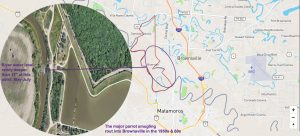
I grew up in Brownsville, Texas. I knew the major individuals involved in the legal, quasi-legal and illegal parrot trade on both sides of the River as far south as Ciudad Victoria. During the time that USDA-licensed parrot quarantine sheds were operating in Brownsville, I surgically sexed and tattooed most of the mature parrots that passed through them. At the time, only three people knew how to perform the procedure: Ken Fletcher at the San Antonio zoo, Michael Coffee, a San Benito OBGYN and myself. Many smuggled parrots purchased in Ciudad Acuña, Reynosa and Matamoros eventually passed through my San Antonio facility, Castle West Animal Hospital. So I knew most of the AFA members that lived there well. In the 1980s, they established a meeting point at a McDonalds on the south side of San Antonio where they exchanged cash for the mature, trapped, red-crowned and red-lored parrots then being smuggled into Brownsville by a family of shrimp boat owners, the Roussetts. That particular Roussett family lived not far from my parent’s house. My acquaintances, Joe Ramos, undercover USFWS RGV agent and Alex Hazacheck of their San Antonio USFWS office knew about the smuggling operation as well. None of these players, including the Roussetts ever told me about crates of parrots being released because of the approach of Border Patrol agents along the River. These mature wild parrots (“broncos”) were offloaded at the Brownsville Shrimp Basin, not floated across the River. The McDonald’s transfer point only dried up when Agent Ramos helped brake up the ring. (ref) I have no doubt that released red-crown parrots did occasionally join the local RGV parrot flocks and survived; but that is not how our RGV flocks came to be. 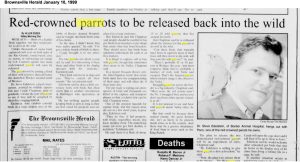
It wasn’t until the hard freezes of the 1980s that killed many of our local palm trees that the Rio Grande Valley parrots found adequate numbers of nesting cavities to reproduce efficiently. Parrots are incapable of making their own tree cavity nests from scratch. But with some parrot modifications, the woodpeckers of the Valley excavate the holes for them.
Lapses In Residency Reports Do Not Abrogate the USFWS’ Duty to Protect Native Red-crowned Parrots In The Rio Grande Valley Of Texas
It is true that during the last 160 years, red-crowned parrots and green conures have been reported only sporadically by the residents of tropical Texas. The lower RGV is a very small island of subtropical climate and riparian vegetation – much closer in ecological makeup to the majority of the Mexican state of Tamaulipas than to the majority of the State of Texas. In early recorded history, the border area had a very sparse, mostly illiterate population. The few with an education were merchants, not folks likely to report bird sighting to Northern ornithologists. That, plus its tiny area (the lower Rio Grande Valley represents less than 1% of the total area of Texas, and is less than 7% the size of the State of Tamaulipas) make it highly unlikely that the presence of red-crowned parrots would be historically documented with any accuracy.
As conditions for the parrots began to deteriorate in Mexico in the 1950s we know that these bird’s geographical range shifted farther to the north. In the 1960s these red-crowned parrots were so common around Washington Park in Brownsville that my wife’s teacher, Ms. Ruth Cavazos, at Annie Putegnat Elementary had to close the windows of her non-air conditioned classroom to be heard over the loud parrot racket (as told to me by another classmate, Anna Owen) . 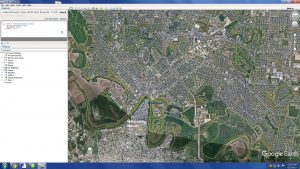
Nesting success is another factor accounting for their population increase in the RGV. A parrot nesting in a palm or ash tree at a Rio Grande Valley golf course is considerably more likely to successfully rear its chicks than one subject to nest robbing in Mexico. Tropical PDSI tables are not always accurate to exact years for a number of factors including hard freezes that can be misinterpreted as low rainfall years.
Critical to red-crowned parrots have always been the Montezuma cypress that line tropical rivers as far north as the Arroyo Colorado that passes through Harlingen, Texas. This species of tree appears to mark the limits of the red-crowned parrots northern natural range. Historical records confirm that in the 1700s the trees, shrubs and plants growing along the Rio Grande River and the Arroyo included stands of Montezuma cypress as well as the other trees that furnished this species of parrot its primary food supply. Montezuma cypress and the rest began to disappear soon after Europeans arrived in the Rio Grande Valley. By 1912, most of the cypress had been cut down. 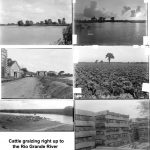
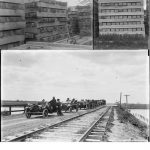
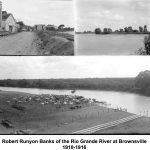
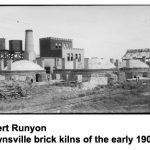
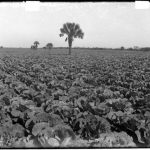
A misconception of what constitutes the limits and fluctuations of natural range is what has led the USFWS to describe the red-crowned parrots of the RGV as “vagrants”, “wanderers”, “accidental” or “casual visitors”, “hypothetical” resident, “strays”, “escapees” and, most recently, “feral” That so many terms have been used, shows the consternation of USFWS bureaucrats in explaining their continuing presence north of the Rio Grande River over so many years. The glaring and quite obvious reason is politically unacceptable to them.
These bureaucrats also fail to understand that the range of parrots in the deeper tropics is not challenged by periodic limitations in their food supplies. Over the eons, red-fronted parrots developed in a unique area that includes the Rio Grande Valley. Here, and south of us to the Sierra Madre mountains, rains are unreliable and winter temperature extremes vary greatly over evolutionary time scales. To deal with those unique challenges, red-crowned parrots developed a strong genetic nomadic nature, to migrate when their current environmental conditions deteriorate. I believe that they are most likely to shift their range during their winter non-breeding flocking months when they find their current situations hostile. Droughts (sequias) as well as severe frosts are facts of life throughout the red-fronted parrot’s range – including the Rio Grande Valley. The nomadic tendencies of red-crowned amazon parrots is their adaptation to those challenges.
Loss of nesting sites and nest robbing may play a part in population dynamics and movement of these parrots as well. In parrots, successful rearing of young is followed by gonadal involution, molt, flocking and major behavioral changes related to drops in their testosterone, estrogen and GnRH levels. When only sub-optimal nesting sites remain and nests are robbed, the bird’s normal yearly hormonal and psychological cycles are more likely to fail. That is why red-crowned parrots confined to indoor lighting drop their feathers now and then (intermittently), while red-crowned parrots in the wild experience a complete post-breeding season molts. How and if that factors into the current population movements of red-crowned parrots into the Rio Grande Valley remains unknown.
Four Maps & A USFWS Preoccupation With National Boundaries:
The greatest danger to the survival of the red-crown parrots of the Rio Grande Valley and Mexico is the refusal of the US Fish & Wildlife Service to recognize them as a native North American species. The first map on the left is the red-crowned parrot’s range as published by the Global Biodiversity Information Facility (GBIF). GBIF maps are not influenced by politics, national borders, special interests or nationalism. They simply present wildlife ranges based on the evidence. If you observe the 2019 GBIF map of the red-crowned parrot’s natural range, you will observe that it includes the Rio Grande Valley of Texas.
The second map was produced by the Mexican ornithologist, Tiberio Monterrubio-Rico in 2016. The historical range assigned to the red-crowned parrot (Amazona viridigenalis) reaches the US Mexican border on the Rio Grande River. Are we to believe that these parrots respect national borders and never crossed the Rio Grande River? Are they prohibited from flying back and forth from the Mexican to the US side? If you believe the third USFWS 2019 map you would have to believe that that was true.
The third map is the new 2019 range map produced by the US Fish & Wildlife Service’s Albuquerque office. Texas is part of the Albuquerque sector. The Albuquerque office carefully moved the parrot’s range in Mexico a little bit south so that they had room to draw a circle around the Rio Grande Valley flocks and label all parrots here escaped feral pets. Besides being down right silly, this new map abrogates the USFWS agreement of 2011 that acknowledges that the Rio Grande Valley is simply the northernmost portion of the parrot’s native range. In doing so, they also abrogate their duty to protect these birds in their United States portion of their range. [pertinent paragraph in red] Parrots have no respect for national boundaries, international agreements. or make-believe maps. It is Nature that determines their range. These sort of bureaucratic shenanigans erode public trust in the USFWS, a Federal institution that has, to date, benefited from wide public trust.
The fourth map is my conception of what a legitimate map of the red-crowned parrots native range should look like in 2019.
The USFWS appears highly dysfunctional when it comes to classifying the red-crowned parrots of the Rio Grande Valley as native to the RGV or feral escaped pets. They can not seem to make up their mind. On April 26, 2019 they and the National Park Service signed off on the Federal Energy Regulatory Commission’s LGN environmental impact study listing the red-crowned parrots of the Rio Grande Valley as a United States, federally listed native species candidates. (ref) That April decision was from the same Corpus Christi USFWS field office team that listed the birds as feral and non-protected in the United States in February of the same year. On 6/4/2019 the Corpus Christi Ecological Services Field Office of the US Fish & Wildlife Service, reversed that position and acknowledged that red-crowned parrot are a native North American species endemic in part to the Rio Grande Valley of Texas. However they announced that because the parrots living in Texas are not mentioned in the Migratory Bird Treaty Act of 1918, they are not entitled to federal protection.
However the USFWS website describing these parrots still refuses to acknowledge their presence in the RGV, describing their native range as entirely in Mexico. 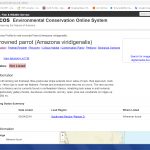
and again in 2014 .
So including the USFWS 2011 study, that now gives us one USFWS decisions that the parrots are native to the Rio Grande Valley and eligible for federal protection, one that they are not native to Texas, one that they are native to Texas but are not federally protected, one that says they are only native to Mexico. One that says they are migratory and two that say they are non-migratory.
The Legacy Of Richard Schubot, The Parrot Aficionado Clubs And Their Influence On The Downfall Of The Wild Parrots Of North And South America- Lust Versus Love
I only take you to these two subjects because both have legacies and exert strong lobbying efforts to this very day that are quite likely to influence the decisions of the US Fish & Wildlife Service regarding the red-crowned parrots of the Rio Grande Valley and their safety from harassment. Neither want the parrots listed as native to the Valley.
Some people, like you and I, admire wild birds in their natural settings. Others have a hunger to possess them. Such a man was Richard Schubot. Like the “collecting Naturalists” of old, Mr. Schubot was a well-to-do man. He owned 15 McDonalds Hamburger franchises. At one time, he owned a pet shop. But unlike the collecting naturalists of old, he was not content with the bird’s hide or eggs. He wanted his great collection of parrots to be alive and he had a reputation for getting what he wanted – “one way or another”. A cursory search yielded thirty-four court cases he and his family were involved in. A number of their associates had less than sterling reputations as well. Besides his parrot compound in Loxahatchee which was patrolled by armed security patrols, and bodyguards, Schubot and his friend, Dr. Bernie Levine, who owned a Miami parrot import shed, eventually purchased the roadside amusement park, Parrot Jungle (aka Jungle Island), where parrots were sold in the gift shop – no questions asked.
I have been told by people in the know that the majority of the parrots in commerce at the time has been smuggled into the United States APHIS-licensed parrot sheds using false CITES origination documents. The stress of capture and the crowding and mistreatment they experienced in the Miami sheds caused enormous mortality; but the trafficking was still lucrative for all concerned. Importation also broke the birds’ resistance to a virus disease that caused the unfortunate creatures (generally cockatoos) that Schubot possessed to loose their feathers and portions of their beaks and claws. Schubot ’s imported macaws were also dying of macaw wasting syndrome. Vexed that none of the Miami veterinarians or those at the vet school in Gainesville could cure his parrots (gossip at the time was that Gainesville turned him down flat when he offered to fund a parrot disease laboratory there) he chanced upon an acquaintance of mine, Dr. David Graham, at the time an avian pathologist at Cornell University. That was the beginning of the Schubot Exotic Bird Health Center
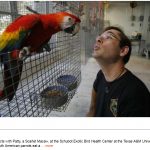
People who lust for parrots and/or breed them for profit have a national organization. It is called the American Federation of Aviculture (AFA). They hold periodic conventions. Their 1988 convention was in Tampa, Florida. You can read their 1988 convention brochure here if you ask me for it Dr. Graham attended, representing the Schubot Exotic Bird Health Center at A&M. The names are a who’s who of the people of the day involved in importing parrots and/or attempting to breed them for money. I knew most of them. Buzz Paree owned the Gators of Miami parrot import sheds. He told me his Dad tried to make a go of it importing caimans, he sold as baby aligators hence the name). Buzz contributed door prize parrots. A congenial man, Buzz was later nabbed in a USFWS sting operation. Rosemary Low represented Loro Parque – not renown for their compassion for animals either. I do not know if Tony Sylva was in attendance although he represented the AFA ’s Midwestern region at the time. The law finally caught up with Tony as well. As for the rest, they could, like Captain Renault in Casablanca, be paraphrased as “shocked, shocked to find that smuggling and cruelty is going on in here”. After operation psittacine the AFA still sent a letter to USFWS in an attempt to rout the smuggled birds to them. The article in Forbes suggests that these people fear added regulations if the wild red-crowned parrots of the Rio Grande Valley were to receive protected status.
How Can I Do My Part To Protect These Last Of The North American Parrots?
Forward this article to as many people as you can. Sunshine on a problem is often its best cure. I do not believe the parrots of the Rio Grande Valley will be truly safe until the US Fish & Wildlife Service is taken to court again and forced to protect them as they do all other native American birds. If you know of public interest law groups or altruistic attorneys that would like to take the lead in doing so, let me know.
When bureaucrats are faced with having to make a decision that favors one interest group over another, they generally appoint another “study committee” that takes a year or two to report back. During that time, they hope that the public will loose interest or that there will be new developments that make it unnecessary for them to make a decision one way or the other. It is time to end the plight of the parrots of the RGV once and for all. Another tactic bureaucrats commonly used is to blame the problem on someone else “we are very sympathetic to your point of view but our hands are tied“. The June, 2019 stance of the USFWS Corpus Christi office to this article is “don’t worry about the parrots loosing their federal protection in the United States, the State of Texas will protect these parrots” I do not believe that the US Congress ever gave the USFWS the right to abdicate their responsibilities to individual states when faced with difficult decisions – nor do I know of any other species of bird where that ever occurred. How can any creature be both native and feral? The ornithologists of TPW realized these parrots were native to the RGV quite some time ago.
Bird watchers do our parrots no service when they point out breeding parrot pairs and roosting flocks to academics intent on experimenting on them. Whether they are out for beer money or PhDs, we don’t need more Polo Cotorros and Snake Kings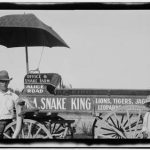
I mailed her a copy of this article. She never responded, but within days, the photograph of her and the young parrot disappeared from the internet.
Let the USFWS know that refusing to grant endangered species protection to RGV and Mexican red-crown parrots is scientifically and intellectually unjustifiable. These birds are the greatest treasure of the Rio Grande Valley, perhaps the last hope for an entire species. With Carolina parakeets already driven to extinction, the Valley flocks are the last surviving native American parrots. We should be intensely proud of them and defend them against all comers. They should not have to rely on local ordinances and the State for their protection.
Urge your City Council and Counties to continue to pass local laws making it a crime to harass local wild parrots until the USFWS can finally get it right. Be sure your ordinance prohibits capture of healthy parrots for any purpose including “scientific study” application of tracking devices, cameras in nest cavities, harassment with drones, etc. – all of which are cruel and stressful activities that cause persistent behavioral alterations. The yearly Japanese whale harvest is supposedly conducted for “scientific study”
Visual observation from a distance provides sufficient parrot census data. Stool and shed feathers collected under roosts give enough general health and wellness information. One can tell from a single shed wing feather if a parrot suffers from malnutrition or chronic disease. I collect a DNA sample from every parrot or conure that it brought to me. They are eventually destined for a comparative study by the American Museum of Natural History, NY, to DNA samples collected in the late 1800s and early 1900s.
Explain to your neighbors not to be quick to take down dead palm trees. Leave their trunks standing when they die so woodpeckers can turn them into parrot nesting sites. Trimming a palm’s canopy for eye-appeal weakens the health of palms and makes them more susceptible to fatal fusarium wilt and other palm diseases.
In the wild, Red-crowned amazon parrots in the rio grande valley feed on the seeds and fruits of Texas ebony, anaqua ,brazil, pecan and coma. At bird feeders, a mix of fresh fruit and fresh corn, sweet potato and sunflower seeds and peanuts all sold for human consumption is fine. They like the crunchiness of carrots. But too many carrots can turn their feathers yellow. Corn sold for animal consumption can contain toxins. They love thawed blueberries. But planting the trees whose fruit and seeds red-crowned parrots naturally feed on is a much better option.
Artificial nest boxes need to be grandfather clock silhouette in shape with an internal ladder to the bottom. The bottom needs a 6 inch layer of uncompacted mulch. If not adequately mulched, hens often accidentally breaks their eggs. If the box is not deep enough, the hens often throw the mulch out of nest entrance hole which also results in broken eggs. A strip of spinosad-impregnated (Naturalyte™) string or sponge near the box entrance discourages colonization by bees. This is one of my conure nest boxes in Florida strapped to a palm tree: 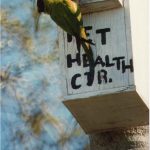
There are 33 pdf reference articles associated with this article. You might be able to read them through the internet Wayback machine. If not I can supply them to you if you ask me to.


